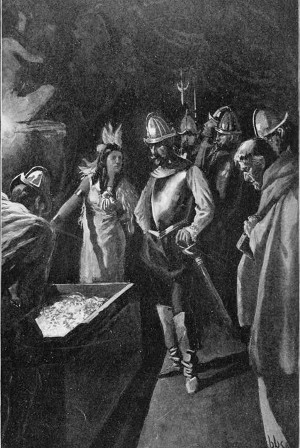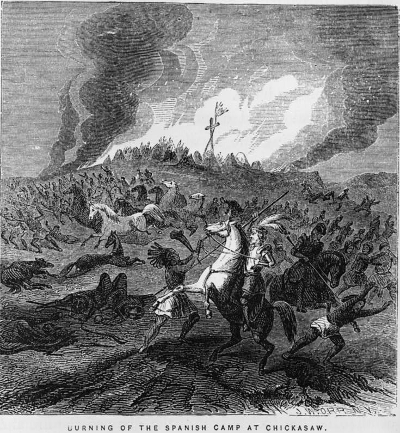
Cofitachequi was a province of Muskogean-speaking Indian people located in what is now South Carolina in the area bordered by the Santee, Wateree, and Pee Dee rivers. Spanish slavers searching the southeastern Atlantic coast for Indian slaves learned of it from the people they encountered and captured. An Indian man enslaved by the Spaniards told them of an area ruled by a powerful chief. His description contained many elements of Mississippian culture, including earthen mounds.
In 1539 Hernando De Soto's army landed on the Gulf Coast of Florida and began an assault on the southeastern Indians, looking for riches to plunder. During their march through Florida they captured a young Indian boy they called Perico. He was a trader from a town in the chiefdom of Cofitachequi. He told the Spaniards that Cofitachequi was ruled by a female chief who collected tribute from the towns in the chiefdom, and they sometimes paid in gold. Perico convinced them that the riches they were seeking would be found there and that he could lead them to it. DeSoto made plans for the army to head to Cofitachequi.

In the spring of 1540, De Soto plundered his way from Florida, through the area we now call Georgia, and on to Cofitachequi. On May 1 the army arrived at one of the major towns of Cofitachequi, located on the Wateree River, probably the archaeological site now known as Mulberry Mound. They met a delegation of the ruling class and, with Perico acting as interpreter, De Soto told them that he came in peace and wanted to meet the chief.
A short time later a woman the army's chroniclers called The Lady of Cofitachequi arrived, carried on a litter covered with a white cloth. They described her as extremely beautiful. Perico told De Soto this woman was the niece of the female paramount chief of Cofitachequi, and she had come to the town to deal with some of the principal men who were refusing to pay tribute. Perico may have been trying to protect The Lady by telling the Spaniards she wasn't the chief, but several of DeSoto's chroniclers considered her to be the paramount chief. She welcomed De Soto and presented him with gifts of animal skins, cloth, and freshwater pearls. She then set aside half of the town for the use of the army and gave them food, including turkey and venison.
De Soto then asked about the precious metals and gem stones he had been told could be found at Cofitachequi. The Lady commanded the people of the town to bring all they had. They brought freshwater pearls, copper, and sheets of mica. This disappointed the army - they expected to find gold and silver. Then the Spaniards began looting the mortuary temples where the bodies of the dead were kept stored in wooden caskets, taking more than 200 pounds of freshwater pearls.
When they had taken everything of value they could find, they had the Lady of Cofitachequi lead them to her town, Talimeco, about four miles away. Again, they looted the mortuary places of everything they wanted. The army needed food to take along on their march, and they wanted corn, but Cofitachequi had been depopulated by disease 2 years earlier (probably brought by earlier European slavers and explorers), so the Indians didn't have a large supply on hand. De Soto sent out parties from the army to find all the corn they could carry.

De Soto stayed in Cofitachequi for 12 days, the army eating most of the food in the province. By this time the people of Cofitachequi had had enough of the Spaniards and were threatening to take action against them. De Soto took the Lady of Cofitachequi hostage. He decided to make his way to a province called Coosa, which he had heard was very rich and might have an adequate supply of corn. The army headed for Coosa, taking along the Lady, along with a contingent of her attendants, as hostage and guide.
Coosa lay to the west of Cofitachequi, but instead of leading De Soto on the direct route the Lady led the army to the northwest, toward the mountains and the province of Chalaque, hoping to get them lost. In the mountains, saying she had to go relieve herself, she took one of her female slaves and escaped, carrying away a chest of valuable pearls. She made her way back to one of the border towns of Cofitachequi, and De Soto never saw her again.
Sources:
Books: (The Native History Association is an Amazon Associate. If you buy using one of our Amazon Book links, we get a small percentage of the sale, and we appreciate that support.)
